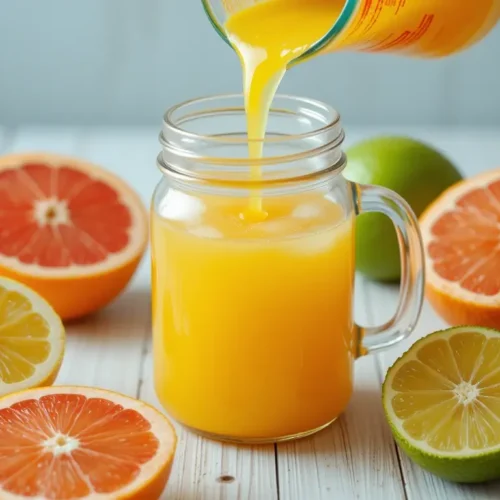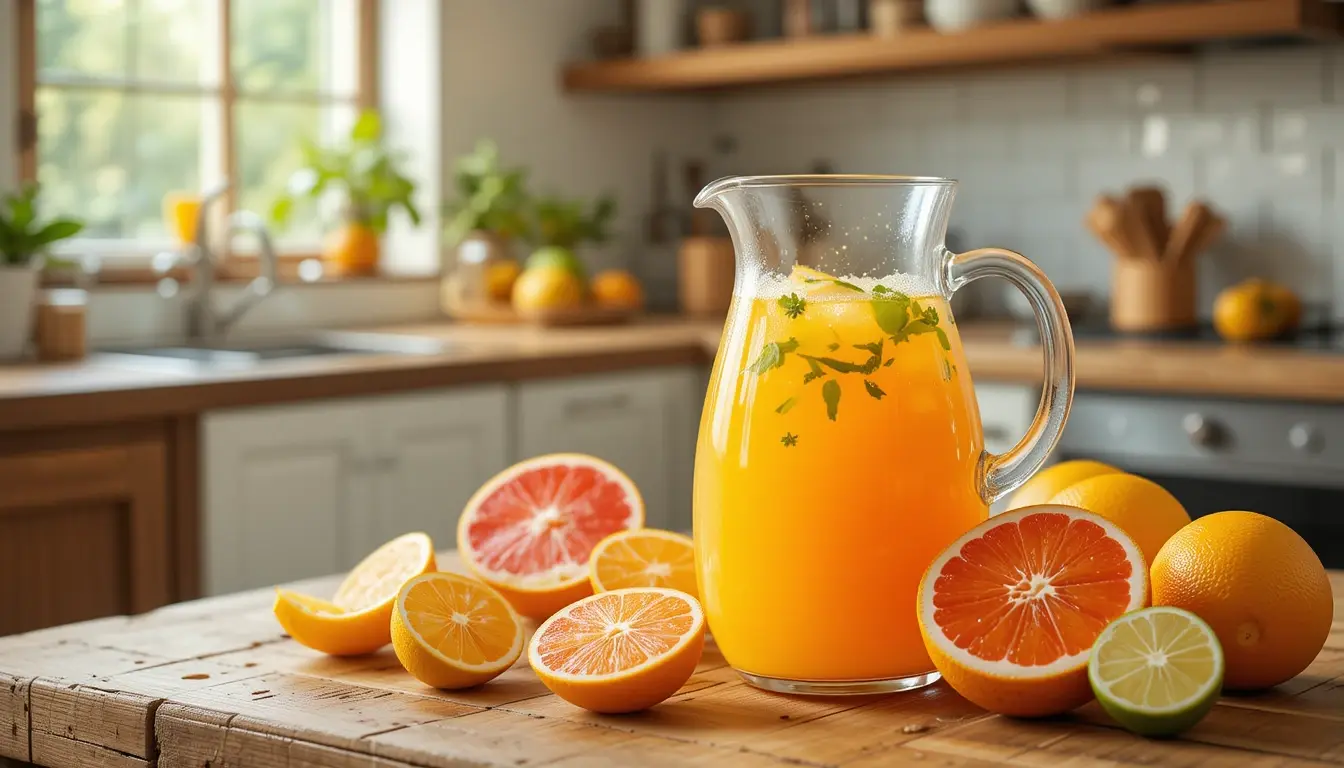Citrus juice has long been a staple in my kitchen, especially in the warmer months when North Carolina’s sun hangs a little longer in the sky. I remember sitting on my grandmother’s back porch with a pitcher of fresh citrus juice that tasted like sunshine in a glass. That memory has inspired countless variations in my kitchen, including this specific blend of mandarins, oranges, grapefruit, lemon, and lime. The brightness of citrus doesn’t just wake up the palate, it brings back the warmth of slow mornings, southern air, and the kind of peace that only comes from something homemade. This recipe is one of those quiet joys. It requires no fancy juicer, just ripe fruit, and the instinct to taste as you go. Whether you’re looking for a morning reset or a zesty afternoon refresher, this is the citrus juice you’ll want to come back to. In this article, we’ll explore the soul of citrus juice, how to make it beautifully balanced, and even answer your top juicing questions, like what to do if you don’t own a juicer.
Table of Contents
Citrus Juice Recipe
The Story Behind This Citrus Juice Recipe
How Citrus Juice Became My Everyday Staple
I didn’t grow up around citrus groves, but I remember the magic those little orange fruits brought into our cold Midwestern winters. Every year, a box of bright oranges would arrive from family down south. We’d slice them open at the kitchen table, juice running down our fingers, sunlight in every bite. That memory stayed with me. These days, living just outside Asheville, citrus juice has become a simple ritual in my kitchen, not just a seasonal treat.
This recipe is one I’ve made for years, adjusting slightly each season depending on what’s freshest. It brings together juicy mandarins, oranges, grapefruit, lemon, and lime for a well-rounded citrus juice that’s both sweet and tart. The result is refreshing without being overpowering, with just enough zip to wake up your taste buds. I often sip it first thing in the morning or serve it with brunch when friends gather. Unlike store-bought juices that lean too sweet or flat, this blend feels alive fresh-squeezed, slightly pulpy, and deeply satisfying.
If you’ve ever made Juice Citrus, you know there’s something special about creating flavor from scratch. No two batches are exactly the same. Sometimes I use an extra lemon for brightness, sometimes more grapefruit when I want a little bitterness. That’s part of the beauty.
A Glass of Citrus Juice and a Quiet Morning
There’s a kind of stillness in those early hours when the house is quiet, and the sun is just beginning to rise over the Blue Ridge. That’s when I love to make citrus juice. No machines whirring, no rush. Just peeling fruit, sectioning each piece by hand, and letting the scent of fresh citrus fill the room. The rhythm of juicing, squeezing, and tasting brings me back to the roots of what I love about cooking. It’s tactile, soulful, and real.
Sometimes I’ll make a big pitcher and keep it chilled for later. Other days, it’s just enough for one glass, sipped slowly while I write or plan supper club menus. If I have a slice of Pineapple Coconut Dream Cake waiting on the counter, even better. Sweetness meets acidity in the best possible way.
This isn’t just about making a drink. It’s about pausing, tasting, and creating something honest from simple ingredients. That’s why this citrus juice recipe isn’t just one I use it’s one I trust.
Crafting the Perfect Citrus Juice Blend
How to Make Citrus Juice Without a Juicer
Don’t let a lack of equipment stop you from enjoying this bright, nutrient-rich citrus juice. While a juicer is certainly convenient, there are other simple ways to extract flavor from fresh fruit. All you need is a fine mesh strainer, a sturdy spoon, and a little patience. Begin by peeling your fruit and cutting it into manageable chunks. Mandarins and oranges are especially easy to break down by hand. Place the pieces into a large bowl, then use a potato masher, muddler, or your clean hands to press the juice out. Once you’ve crushed the pulp, pour everything through a strainer to separate the liquid. It’s a method that might take a few extra minutes, but the results are just as satisfying. You’ll still get that tangy burst of natural citrus, without any bitterness from the pith or peel.
This technique works well with softer citrus like mandarins, and if you warm the fruit slightly beforehand by leaving it at room temperature, it becomes even easier to juice. Just be sure to roll firmer fruits like lemons or limes on the counter first. That gentle pressure loosens the juice inside. I’ve done this method countless times when testing recipes away from home or while camping. It proves that fresh citrus juice doesn’t require fancy tools just fresh ingredients and a little intention.
For more on creating juice blends that sing with flavor, you can check out ideas from Juice Citrus or Japanese Pink Salt Recipe where the natural beauty of citrus takes center stage in creative and seasonal combinations.
Choosing and Balancing Your Citrus Fruits
When making citrus juice, the quality and variety of your fruit truly make a difference. For this recipe, I like to combine 10 peeled mandarins, 5 peeled oranges, 1 grapefruit, ½ lemon, and ¼ lime. This mix offers a vibrant range of sweet, tart, and slightly bitter notes. Mandarins bring a mellow sweetness and soft texture. Oranges add brightness and depth. Grapefruit introduces complexity without overpowering. And just a touch of lemon and lime provides a sharp, cleansing finish.
The key is to taste as you go. If you’re using particularly sour lemons, you may want to balance things out with a touch of agave syrup. Not all citrus is created equal, and seasonal changes can affect acidity. Don’t be afraid to make the recipe your own by adjusting proportions or swapping in other citrus you love. Blood oranges, for example, lend a rich color and deeper sweetness, while Meyer lemons can soften the tartness.
Fresh citrus juice is as much about instinct as it is ingredients. Trust your palate, and you’ll find the right balance every time. And if you’re serving this alongside something sweet like Strawberry Banana Pudding Cookies or Mini Cupcakes, you may even skip the sweetener altogether to contrast the richness of dessert.

Citrus Juice Recipe
Ingredients
- 10 mandarins peeled
- 5 oranges peeled
- 1 grapefruit peeled
- ½ lemon
- ¼ lime
- Agave syrup to taste optional
Instructions
- Cut the oranges and grapefruit into chunks if too large to fit in the juicer.
- Juice the mandarins, oranges, and grapefruit.
- Squeeze in the lemon and lime juice by hand for balance.
- Taste the juice. If desired, stir in agave syrup or another sweetener to your liking.
- Chill or serve immediately over ice. Enjoy!
Notes
- Use blood oranges or Meyer lemons in place of regular oranges or lemons for seasonal variation.
- Store in the fridge for up to 3 days in a sealed glass jar.
- You can juice by hand using a mesh strainer if you don’t have a juicer.
Nutrition Estimate (per serving)
- Serving Size: 1 glass (approx. 8 oz)
- Calories: 110
- Sugar: 21g
- Sodium: 2mg
- Fat: 0g
- Saturated Fat: 0g
- Unsaturated Fat: 0g
- Trans Fat: 0g
- Cholesterol: 0mg
- Carbohydrates: 28g
- Fiber: 3g
- Protein: 2g
Why Citrus Juice Is More Than Just Refreshing
Health Benefits of Fresh Citrus Juice
One of the best parts about drinking fresh citrus juice is how naturally nourishing it is. Without adding anything artificial, you’re getting a vibrant dose of vitamin C, along with other essential nutrients like potassium, folate, and antioxidants. That combination supports your immune system, promotes hydration, and helps keep your skin clear and glowing. Especially during the colder months, I reach for citrus juice to feel balanced and restored.
Because this recipe uses multiple types of citrus mandarins, oranges, grapefruit, lemon, and lime you benefit from the variety of flavor and nutrition they each bring. Oranges and mandarins are especially rich in vitamin C. Grapefruit adds a subtle bitterness and is known to support metabolism. Lemon and lime offer digestive support and anti-inflammatory properties. When you combine them in one glass, the result is more than a flavorful drink. It becomes a full-body boost.
Unlike store-bought juice that’s often stripped of fiber and pumped full of sugar, this citrus juice stays close to the fruit’s original form. If you enjoy a little pulp, you’ll also get a bit of fiber. And when you make it fresh, you’re drinking something alive made moments before, with no preservatives.
If you’ve got younger ones around or want to introduce them to something naturally sweet, citrus juice is a great start. I often serve it alongside homemade Mini Cupcakes for brunch. The tartness of the juice balances beautifully with a little sweetness from the treat.
Serving Citrus Juice Like a Pro
There’s something special about pouring citrus juice into a chilled glass. Maybe it’s the color the golden tones from oranges and mandarins, touched with pink from grapefruit and just a hint of lemon yellow. It’s cheerful before you even taste it.
When I serve this to guests, I love using clear glass carafes. It shows off the natural color and sets a casual yet thoughtful tone. A few slices of citrus on the rim or floating in the juice adds charm without fuss. If you’re feeling fancy, a quick run of citrus peel along the edge of the glass gives a bright aroma when someone takes their first sip.
If you’re hosting brunch or a light lunch, this juice pairs beautifully with citrus-based desserts. I often bring it out with Strawberry Banana Pudding Cookies or chilled slices of Pineapple Coconut Dream Cake for that perfect balance of tang and sweetness.
Presentation doesn’t need to be complicated. A mason jar works just as well as a crystal glass. The real beauty comes from the color of the juice and the care you took to make it. Whether you’re serving a crowd or enjoying a quiet morning on your own, citrus juice shines best when served fresh and simply.

Seasonal Citrus Juice Variations and Storage Tips
Creative Twists on the Classic Citrus Juice
One of the reasons I come back to this citrus juice recipe again and again is its flexibility. The base blend mandarins, oranges, grapefruit, lemon, and lime is already full of depth. But once you start exploring seasonal or regional varieties, the possibilities open up even more.
In late winter, I’ll sometimes swap in blood oranges. They bring a deep, almost berry-like sweetness that turns the juice a stunning red-orange hue. In early spring, I reach for Meyer lemons, which are naturally sweeter and more floral than standard lemons. They soften the acidity and add a perfumed aroma that’s irresistible.
You can also play with texture and herbs. A bit of muddled mint or basil adds a fresh twist that pairs beautifully with citrus. For a spiced winter version, I sometimes add a tiny pinch of ground ginger or cinnamon while juicing. It warms the flavor without overpowering the natural brightness.
The beauty of homemade citrus juice is that you’re not locked into one formula. Use what’s in season. Trust your taste buds. If your batch comes out a little too tart, stir in a splash of agave syrup or maple syrup. If it’s too sweet, balance it with a squeeze of extra lemon or lime. Just like with Juice Citrus, every glass becomes an opportunity to fine-tune and make it your own.
How to Store Citrus Juice the Right Way
Fresh citrus juice is best enjoyed soon after making it, while the enzymes and nutrients are at their peak. That said, you can absolutely make a larger batch and keep it in the fridge for up to three days. Just be sure to store it in a sealed glass jar or bottle. This keeps the juice tasting clean and prevents it from picking up flavors from the fridge.
If you want to prep ahead for the week, pour single servings into small mason jars. That way, you can grab one in the morning without having to stir or pour from a larger container. The color may change slightly over time, especially with grapefruit or lime, but the flavor holds beautifully.
Freezing is also an option. Pour leftover citrus juice into ice cube trays, freeze, and transfer to a bag once solid. You can pop the cubes into sparkling water, tea, or cocktails for an easy burst of citrus flavor. It’s one of my favorite ways to reduce waste and keep the taste of summer going year-round.
Just remember, while homemade citrus juice can be stored, it’s never quite the same as fresh. That first-day flavor the clarity, the brightness is what makes it so special. So whenever possible, peel, squeeze, and serve it fresh. It’s a small act that carries a lot of joy.
Conclusion: Sip the Season, One Glass at a Time
Fresh citrus juice is more than a drink. It’s a moment of pause, a taste of sunshine, and a small act of care you can bring into your day. Whether you’re making it for a crowd or just yourself, this blend of mandarins, oranges, grapefruit, lemon, and lime offers a naturally sweet and tangy refreshment that doesn’t need additives or shortcuts.
With simple ingredients and a few minutes of time, you can create a homemade citrus juice that outshines anything from a bottle. It’s bright, balanced, and endlessly adaptable. Serve it cold with a side of Strawberry Banana Pudding Cookies or pair it with Mini Cupcakes and Pineapple Coconut Dream Cake for a truly satisfying spread.
So peel, squeeze, and pour with intention. Your perfect glass of citrus juice is waiting.
For more recipes follow me in Facebook
FAQs About Citrus Juice
I don’t have a juicer. What can I use instead?
You don’t need a fancy machine to make delicious citrus juice. A simple mesh strainer and a wooden spoon can do the job beautifully. Peel your fruit, cut it into chunks, and press it through the strainer over a bowl. This method works especially well with juicy fruits like mandarins and oranges. You’ll still get the fresh taste and nutrients without needing to invest in equipment.
Do you have to peel citrus before juicing?
Yes, peeling your citrus is essential, especially when using a centrifugal juicer or doing it by hand. The peel can add unwanted bitterness to the juice and may contain oils that overpower the flavor. Removing the peel also helps prevent clogging in manual methods. For this recipe, all fruits should be peeled, including grapefruit and lemon, for the cleanest citrus juice taste.
Can I put a whole lemon in a juicer?
Technically, yes. But most of the time, you’ll want to peel the lemon first. The rind contains oils that are quite strong and can make your juice bitter. If you’re using a high-speed juicer, it might break down the peel, but the flavor will change significantly. Peeling ensures a smoother, more balanced juice that highlights the lemon’s tang without the bite of the pith or skin.


2 thoughts on “Citrus Juice for Brunch, Breakfast, or a Simple Afternoon Refreshment”